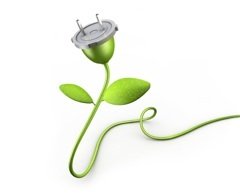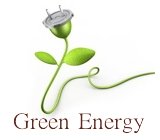Off Grid Power
Realistic Off Grid Energy Alternatives
Off Grid Power Options for living off the grid. A look at Solar Power, Wind, Geothermal and Water Turbine energy alternatives. Live off the grid in comfort.
Green Energy Options for Off Grid Living
Want to live off the grid? Here are 4 strategies for powering, heating and cooling your home and water without any association to the grid.

Any off grid plan begins with an evaluation of your current energy needs. Applying some energy conservation tips now, can save you thousands - even tens of thousands - of dollars on your alternative energy setup.
The further you live from a source of grid power the more sense off grid living makes from a financial perspective.
Establishing grid power infrastructure (lines and poles) to remote locations costs way more than bringing in even the most expensive system. It just isn't realistic to pound in power poles and string power lines to remote locations. The cost per mile quickly adds up to considerably more than an off grid system would cost and still, you'd have a monthly power bill.
Although it is possible to live off the grid in urban and suburban areas, the more land your home sits on, the more potential exists for a variety of resources to be available.
Many off grid power alternatives use the same infrastructure in your home to distribute your energy as with a conventional utility system (solar is converted to AC power and is then distributed via your normal wiring system, geothermal can be incorporated into an existing duct system).
Consider using more than one of the following methods to meet your household needs more seamlessly through changing seasons and weather conditions.
Here are 4 major types of alternative energy, one or more of which is likely to be present on your property in sufficient amounts for comfortable living off grid.
Solar Energy - Off Grid Power
If you receive 5 or more hours per day of uninterrupted sunshine on your property, you're in luck. Solar energy is a viable option and of all the alternatives, solar is by far the most versatile.
South or southwest exposure (in the northern hemisphere) is best for a solar array. When choosing panel location ensure that large trees or buildings do not interfere with the trajectory between the sun and the panels, especially during the winter when the sun doesn't rise as high in the sky.
You'll need ample room to display your panels either on a roof or the ground. In some cases a second off grid power source is used during seasons when the sun is blocked or simply doesn't have the strength to produce sufficient power.
Solar energy can be collected in different ways depending on your household needs.
Here are three ways to use the sunshine that falls on your property.
- Passive solar energy simply delegates the heat and light to warm and illuminate your living space.
- Solar water heaters pay for themselves within a few years; after that, free water heating.
- A residential solar power system converts sunshine into household energy.
Wind Power - Off Grid Power
Like the windmills of old, the new generation of wind turbines redirects energy by using the wind to turn turbines, but now they do it better, more efficiently and cheaper.
Small scale wind turbines are becoming a popular option for individual householders that are interested in getting off the grid.
Installing a wind turbine is an option in places where you have a consistent breeze - preferably over a smooth hilltop with a long fetch (fetch is a nautical term meaning distance travelled, uninterrupted by obstacles).
Measure the wind velocity at your site (or check government statistics) over a year to understand the fluctuations and rhythms of the wind on your hilltop before you purchase any of your components. Be realistic, accurate measurements will ensure that you're purchasing the right size for the windspeed and desired power production.
Windspeed is higher and more consistent at higher altitudes. A tower is necessary (in the 100 foot range) to situate the blades in the steady wind flow with a long fetch.
Ideally, you'll have an acre or more of land when using wind power. A wind turbine can in some cases be erected in an urban area but there are some specific needs that would have to be met for it to function happily and at peak efficiency. The biggest issue will be obstacles in the path of the wind. Towers can help to raise the blades into an area of unobstructed air flow in some cases.
Expect to pay between $5,000 USD and $22,000 USD for an installed wind power system.
Heat Pump - Off Grid Power
Reminder
Methods for producing electricity from geothermal energy have questionable environmental impacts. The earth energy methods we recommend are for heating and cooling purposes and quickly earn back what they cost in environmental impact and cash.
Heat pumps are hot! Not just because of their home and water heating capabilities either. They're taking off in popularity as a long term heating, cooling and hot water solution and can pay for themselves in a mere 5 to 7 years.
A heat pump moves heat from one place to another and it's dual direction capabilitiies mean that it can move heat into or out of your home, making it very practical for a home's HVAC (Heating, Ventilation, Air Conditioning) system.
Rather than creating heat (by combustion) the heat pump extracts existing heat from the air or ground and transports it to another location.
- A Ground Heat Pump extracts heat from underground (or under a lake or large pond) and moves it into the residence.
The temperature at 6 feet underground remains fairly consistent and is not influenced by surface weather patterns. The heat can be captured and brought to the surface to help warm or cool a space or a water supply.
Coils of pipe or hose are laid in an excavation or at the bottom of an existing lake or deep pond on the property. A solution is circulated through the hose and the temperature is transferred to the solution.
In reverse the unit will move the heat from the house and deposit it into the ground.
- An Air Heat Pump moves heat from outdoors to indoors or vice versa (if you have a reverse capability). Like a refrigerator, the heat is withdrawn from the air outside and deposited into the house. Alternatively the heat from the house can be moved from inside to outside and cool the space.
Heat Pumps extract only the heat molecules and move them to a desired location. There's more to it than that and you can find the whole story here.
The contours and composition of your property will determine which type of system is best for your purposes.
In any case, geothermal systems pair well with existing HVAC ducting and distribution systems.
Water Turbine - Off Grid Power
Water turbines can produce sufficient electricity to completely power an off grid home. A constant source of running water is necessary. No need for a raging river, even a small stream can be configured to turn a small turbine.
If you have a source of running water on your property like a stream, river or a waterfall you can capture the energy of the water to turn small turbines which will produce power. Operating on the same principle as wind power, water, rather than wind, turns the turbine. It's necesary to have, or be able to develop, two aspects in order to build a water turbine and they are... head and flow.
Head is a vertical drop (water falling over an edge)
Flow is volume of water moving, calculated as flow per second or flow per minute.
Reminder
Check with local authorities regarding restrictions that may be in place for diverting waterways in your area.
In Conclusion - Off Grid Power
To live completely off the grid in all seasons you may need to use more than one form of energy. Particularly if you live in a climate of extremes.
Spend time exploring your property for useable sources of green energy. Look for sunny south or west facing areas, windy areas atop an unobstructed hill, running water such as a stream or river, still water features like large ponds or a lake, deep soil that's easy to excavate. Take your cues from the resources available on your piece of land.
Visitors to our Off Grid Power page may also be interested in the following pages.
Living Off Grid










